The Cocoon Galaxy is a barred spiral galaxy located approximately 25.1 million light-years away in the northern constellation Canes Venatici (the Hunting Dogs). It has an apparent magnitude of 9.8 and an apparent size of 6.3 by 3.1 arcminutes. The galaxy is listed as NGC 4490 in the New General Catalogue.
Notable for its cocoon shape, the Cocoon Galaxy is about 40,200 light-years across. It is interacting with the smaller NGC 4485, an irregular galaxy located 29.1 million light years from Earth. The smaller companion has a diameter of 11,000 light years and an apparent visual magnitude of 11.93.
NGC 4490 and NGC 4485 are one of the nearest interacting galaxy pairs to the Sun. They are listed as Arp 269 in American astronomer Halton Arp’s Atlas of Peculiar Galaxies.
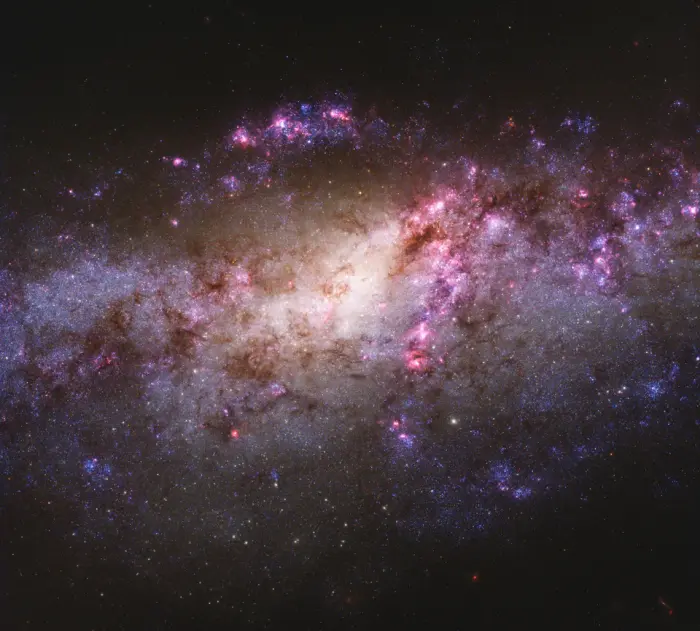
The Cocoon Galaxy, from the Hubble Legacy ExtraGalactic UV Survey (LEGUS), image credit: Judy Schmidt (CC BY 2.0)
The low-mass galaxies are separated by 9.3 kiloparsecs (30,333 light years). Together, they have about a fifth of the mass of the Milky Way galaxy. They are surrounded by a vast hydrogen envelope and connected by a dense bright of gas. Hubble images of the stellar stream that connects the galaxies show that it is about 25,000 light years long. It harbours many young, exceptionally massive and hot blue stars.
The enormous hydrogen cloud that surrounds the galaxies stretches about 60 kiloparsecs (~ 196,000 light years) from the optically visible pair and has a total diameter of around 120,000 kiloparsecs.
NGC 4490 and NGC 4485 are now receding from each other after making their closest approach (perigalacticon). The close encounter has triggered a burst of star formation in the colliding companions. Both galaxies are experiencing an intense star formation rate.
The larger barred spiral galaxy NGC 4490 was heavily affected and distorted out of shape by the encounter. The smaller starburst galaxy NGC 4485 was also a spiral galaxy once, but any trace of its past spiral structure has been all but erased by the interaction with the larger galaxy.
In 2020, a team of astronomers led by Allen Lawrence of the Iowa State University confirmed that NGC 4490 has a double nucleus structure. The team confirmed the binary nucleus while analysing infrared images taken with the Spitzer Space Telescope in the mid-infrared band. They reported the discovery in a study published in The Astrophysical Journal. Lawrence had discovered the two central cores while observing the galaxy in an optical telescope and a radio telescope and then comparing notes.
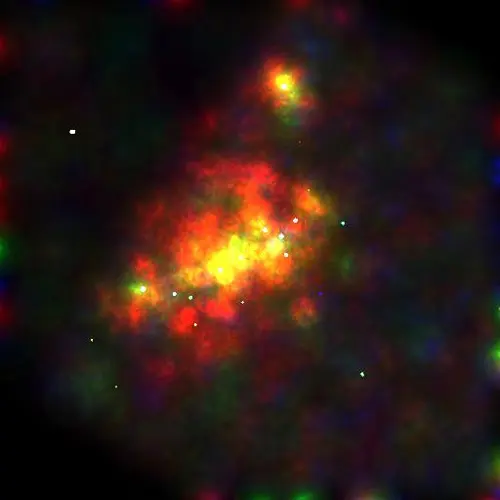
NGC 4485 and NGC 4490 captured by the Chandra X-ray Observatory, credit: NASA/MSFC (PD)
One of the nuclei can be seen in visible light while the other can only be detected at infrared and radio wavelengths. The nucleus is invisible at optical wavelengths because it is obscured by intervening clouds of dust. The two nuclei have similar masses, sizes and luminosities. They are best observed at near-infrared wavelengths.
The presence of the binary nucleus at the center of the galaxy suggests that the Cocoon Galaxy is itself a merger remnant which is now colliding with a smaller companion. The second nucleus is what is left of a smaller galaxy that was absorbed into the larger NGC 4490. The earlier merger explains the extended high level of star formation in the galaxy and possibly the formation of the large hydrogen plume around the interacting pair.
The Cocoon Galaxy is a member of the Canes II Group (Canes Venatici II Group), one of the galaxy groups in the Local Supercluster. Bright members of the CVn II Group include the spiral galaxies Messier 106 and NGC 4242 in the Canes Venatici constellation and NGC 4096 and NGC 4144 in Ursa Major. The dwarf galaxies NGC 4618 and NGC 4625 and the irregular galaxy NGC 4707 in Canes Venatici are also members of the group.
The Cocoon Galaxy has a system of at least 12 satellite galaxies that appear aligned in a plane. Two of the smaller galaxies – NGC 7751 and Dw 1234+41 – form a pair.
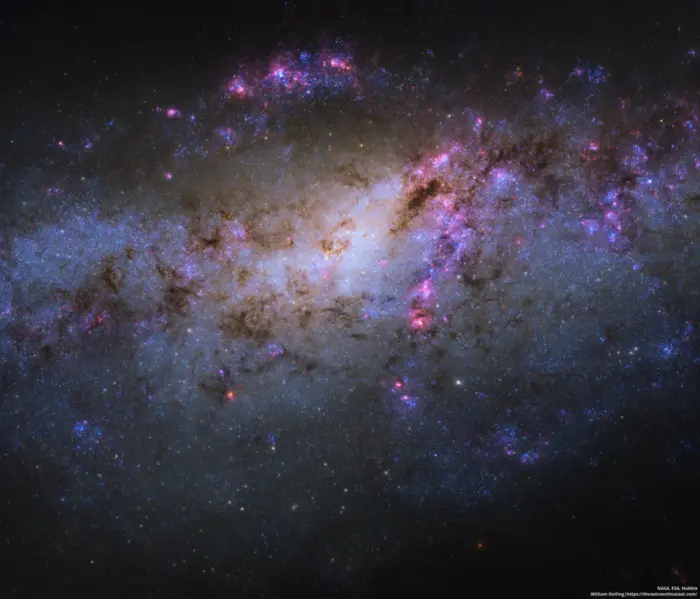
This image, taken with the NASA/ESA Hubble Space Telescope, shows the galaxy NGC 4490. The scattered and warped appearance of the galaxy are the result of a past cosmic collision with another galaxy, NGC 4485 (not visible in this image). The tidal forces of the interaction between the two galaxies have carved out the shapes and properties of NGC 4490. Once a barred spiral galaxy, the outlying regions of NGC 4490 have been stretched out, resulting in its nickname of the Cocoon Galaxy. Credit: ESA/Hubble & NASA; Acknowledgements: D. Calzetti (UMass) and the LEGUS Team, J. Maund (University of Sheffield), and R. Chandar (University of Toledo) (CC BY 4.0)
Facts
The Cocoon Galaxy was discovered by the German-born British astronomer William Herschel on January 14, 1788. Herschel spotted the colliding pair with his 18.7-inch reflector. He catalogued NGC 4490 as I 198 and NGC 4485 as I 197.
NGC 4490 hosted two supernovae and a luminous red nova in the recent decades. The supernova SN 1982F was discovered on April 15, 1982. It had an apparent magnitude of 16. The luminous red nova AT 2011kp was detected on August 16, 2011. It shone at magnitude 16.7.
The most recent supernova, SN 2008ax, was spotted at the Lick Observatory on Mount Hamilton, operated by the University of California, on March 4, 2008. It shone at magnitude 13 and was classified as a helium-rich type Ib supernova.
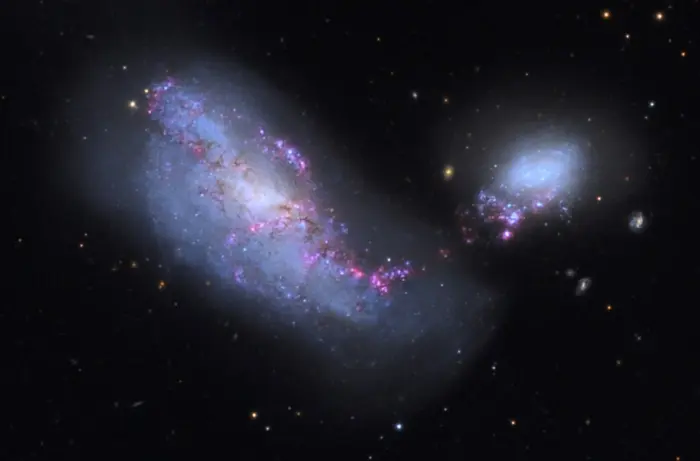
The Cocoon Galaxy, image credit: Adam Block/Mount Lemmon SkyCenter/University of Arizona (CC BY-SA 3.0 US)
Location
The Cocoon Galaxy lies in the faint constellation of Canes Venatici. It is located only ¾ of a degree (40 arcminutes) northwest of the Sun-like star Chara (Beta Canum Venaticorum). Named after one of the dogs represented by Canes Venatici (the other being Asterion), Chara is the second brightest star in the constellation, after Cor Caroli (Alpha2 Canum Venaticorum). With an apparent magnitude of 4.25, it is visible from areas without too much light pollution.
Cor Caroli and Chara appear below the handle of the Big Dipper in Ursa Major. Cor Caroli is the brightest point of light between Alkaid at the tip of the Great Bear’s tail and Denebola at the tail of the celestial Lion. It forms the Diamond of Virgo with the brighter Arcturus in the constellation Boötes (the Herdsman), Denebola in Leo and Spica in Virgo.
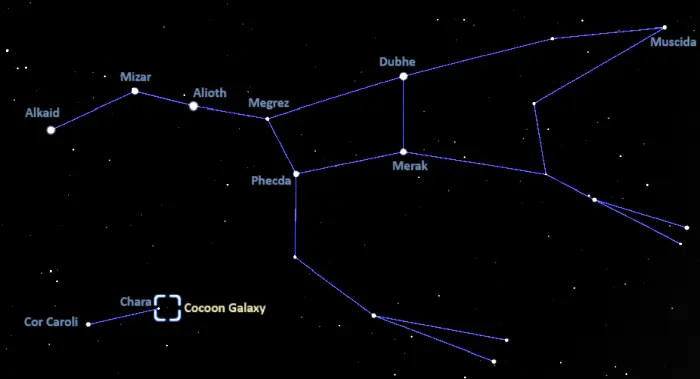
The location of the Cocoon Galaxy, image: Stellarium
The Cocoon Galaxy can be seen in larger binoculars and is a popular target for amateur astronomers and astrophotographers. It is included in the Herschel 400 Catalogue of objects visible in small and medium telescopes.
At declination 41° 38’, the galaxy is best seen from the northern hemisphere. It never rises for observers south of the latitude 48° S.
The best time of the year to observe the Cocoon Galaxy and other deep sky objects in the Hunting Dogs constellation is during the month of May.
Cocoon Galaxy – NGC 4490
| Constellation | Canes Venatici (the Hunting Dogs) |
| Object type | Barred spiral galaxy |
| Morphological type | SB(s)d pec or SAB |
| Right ascension | 12h 30m 36.2390s |
| Declination | 41° 38′ 38.032″ |
| Apparent magnitude | 9.8 |
| Apparent size | 6.3′ × 3.1′ |
| Distance | 25.1 ± 5.0 million light-years (7.7 ± 1.5 megaparsecs) |
| Redshift | 0.001885 |
| Heliocentric radial velocity | 565 ± 3 km/s |
| Size (estimated) | 40,200 light-years (12,340 parsecs) |
| Names and designations | Cocoon Galaxy, NGC 4490, Arp 269 NED02, UGC 7651, MCG +07-26-014, LEDA 41333, PGC 41333, HOLM 414A, KPG 341, KPG 341b, TC 785, IRAS 12281+4155, IRAS F12281+4155, 2MASX J12303636+4138370, 2MASXI J1230368+413825, ISOSS J12305+4139, KUG 1228+419, CGCG 216-008, VV 030a, RX J1230.5+4139, B3 1228+419A, B3 1228+419, BWE 1228+4155, RGB J1230.6+4138, RGB J1230+416, SDSS J123036.08+413835.6, SDSS J123036.23+413840.7, GB6 B1228+4155, 87GB 122809.0+415515, Z 216-8, NVSS J123035+413851, Z 1228.1+4155, 6C 122808+415538, 7C 122808.30+415532.00, PSCz Q12281+4155, MY 122809.4+415548.4, MY 122809.4+413914.6, WN B1228.1+4155, WB 1228+4155, UZC J123036.1+413834 |
Images
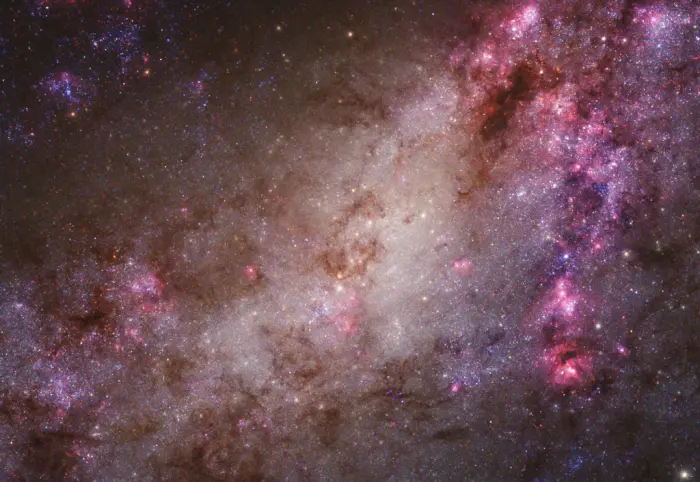
A close-up view of the Cocoon Galaxy, image credit: Judy Schmidt (CC BY 2.0)
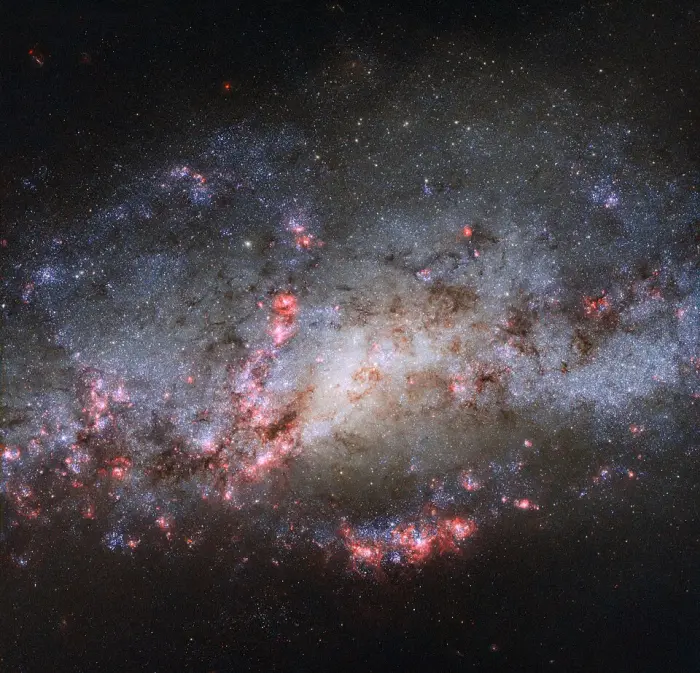
Cocoon Galaxy (NGC 4490) by the Hubble Space Telescope, credit: ESA/Hubble & NASA; Acknowledgements: D. Calzetti (UMass) and the LEGUS Team, J. Maund (University of Sheffield), and R. Chandar (University of Toledo) (CC BY 4.0)
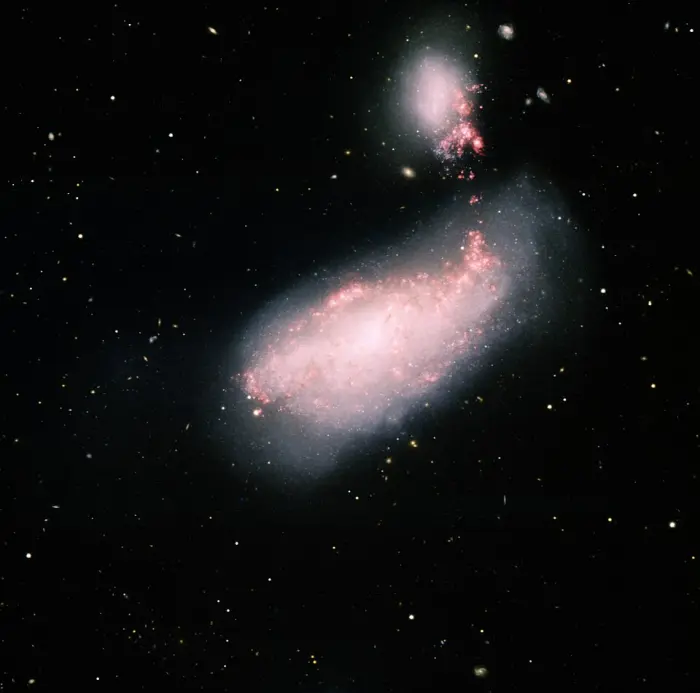
This image was obtained with the wide-field view of the Mosaic camera on the Mayall 4-meter telescope at Kitt Peak National Observatory. NGC 4490 is a barred spiral galaxy (center) that is in the early stages of merging with the smaller galaxy NGC 4485 (upper right). The gravitational pull between the two galaxies is triggering star formation in both galaxies, which can be seen as the bright red clouds of gas inside and between the two galaxies. The image was generated with observations in B (blue), V (cyan), I (orange) and H-alpha (red) filters. In this image, North is up, East is left. Credit: T.A. Rector (University of Alaska Anchorage) and H. Schweiker (WIYN and NOIRLab/NSF/AURA) (CC BY 4.0)
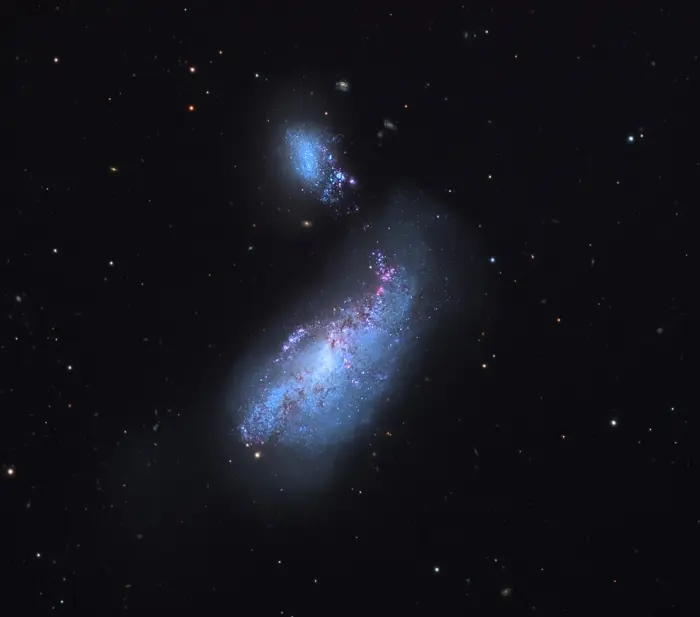
Cocoon Galaxy, credit: Wikimedia Commons/Jschulmann555 (CC BY-SA 3.0)
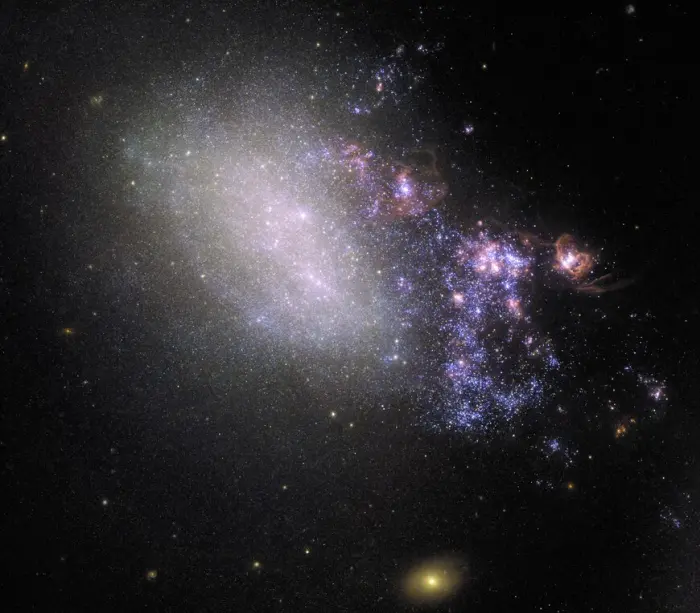
The irregular galaxy NGC 4485 shows all the signs of having been involved in a galactic collision with a bypassing galaxy. Rather than destroying the galaxy, the chance encounter is spawning a new generation of stars, and presumably planets. Image credit: ESA, NASA, Hubble, T. Roberts (Durham University, UK), D. Calzetti (University of Massachusetts) and the LEGUS Team, R. Tully (University of Hawaii), and R. Chandar (University of Toledo) (PD)